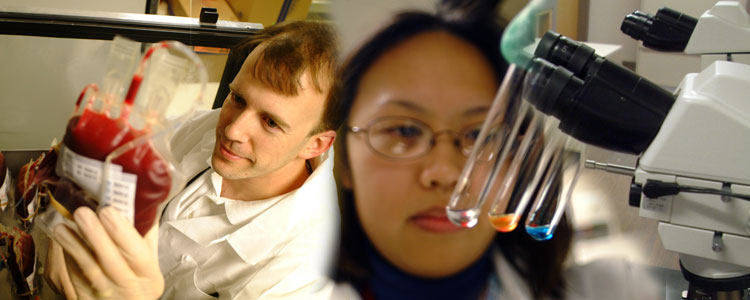
- Augusta University
- Colleges & Schools
- Medical College of Georgia
- Department of Medicine
- Hematology & Oncology | Medicine
- History of Hematology/ Oncology
History of Hematology/ Oncology
Dr. Virgil P. Sydenstricker, first full time head of the Medicine Department (1920s, 30s, 40s, up to 1957), was also one of the country's first great hematologists.
He did all of the hematology (and what little oncology there was) himself until 1956 when the Eugene Talmadge memorial Hospital (now MCG Hospitals and Clinics) was opened and the Medical College went to all full time faculty. At that time, Dr. Sydenstricker brought in Dr. Claude-Starr Wright to be the first Chief of Hematology. Dr. Wright went to school at the Medical College of South Carolina and then trained at Barnes Hospital (Washington University) in St. Louis and at Ohio State. It was from Ohio State that Claude-Starr was recruited here. Barnes Hospital was the most outstanding hematologic center in the South and Border Area and Dr. Carl Moore, Chairman of Medicine and one of the world's first great hematologists, trained many, if not most, of the academic hematologists in the South. Dr. Wright s recruitment here stated a long running relationship with Barnes.
In the period before I came here (1956-1965), Dr. Wright had a few people with him; I know of only two (there might have been more, but I doubt it). Jim Kemp, I know only by name. Robert Lange I know well, because he had been one of my teachers when I was a resident at Barnes. Dr. Wright and Dr. Lange were working on the purification of erythropoietin along with assorted basic scientists: Dr. Ed Gardner in Immunology and Drs. Linda Smith and Jasper Lewis in Biochemistry. In 1965 Bob Lange was leaving MCG to go to the University of Tennessee s Research Hospital in Knoxville to do more concentrated research work on erythropoietin with Dr. Amos Chernoff, another Barnes physician.
After training at NIH in research in erythropoiesis, I went into the Navy. When I was ready to leave the Navy, I called Dr. Moore in St. Louis asking him who in the South was in need of an academic hematologist. He told me that Claude-Starr Wright in Augusta was looking for someone, preferably trained at Barnes, to replace Bob Lange and put me in touch with Dr. Wright. I have been here ever since.
The Section expanded significantly when Jay Bollet was Chairman of Medicine from 1966 to 1974. Dr. Larry Lutcher, another Washington University trained physician, although his fellowship was done under Dr. Osgood at Oregon, came in 1970. A little later, late 1970 or early 1971, Dr. Guy Faguet, who was born in Italy of French parents, reared and educated in Columbia, South America trained in Internal Medicine in Canada, was recruited here upon completion of his Hematology Fellowship at Ohio State.
Dr. Yong Lu, who trained at Boston City with Lou Sullivan, was recruited about that time specifically to the V.A. Hospital. Actually, the V.A. loomed large at that time because of the availability of research funding not present at the Medical College. Clinically though, we all attended back and forth indifferently. Dr. Lutcher would be Chief of Hem/Onc at the V.A. from 1974 to 1978, and then Chief of the whole Section for the Medical College from 1977 (replacing Dr. Wright) to his retirement in 1996.
In addition to the erythropoietin research, we were active with the Southeastern Cancer Chemotherapy Study Group (SECCSG). This group wrote the best hematologic malignancy protocols that I have seen. However, when we moved into more solid tumor work (as the oncologic tail started to wag the hematologic dog) and the groups expanded, the SECCSG was not as politically wise as the SWOG, and it went under.
Emory trained, native Georgian, Leonard Brubaker came to our faculty from the University of Missouri at Columbia in July of 1978. About this same time, Dr. Barbara Chang came full time to the V.A. Hospital to be Chief there. For the life of me, I cannot remember where Barbara trained. When she left here, she went to the University of New Mexico. Although Michael Shlaer, who went to school and took his Internal Medicine Residency here and then his fellowship at Emory, was with us for a few months, our first real home grown faculty member was Dr. Troy Guthrie. Troy went to school here, trained in Internal Medicine at the University of Texas in San Antonio, and then returned here for his fellowship. He joined our faculty upon completion of his fellowship in 1979.
To round out this first half of a recognizable Hem/Onc Division, I would mention Dr. Nancy Stead, daughter of one of the most famous men in 20th Century American Internal Medicine: Dr. Eugene Stead, Chairman of Medicine at Duke University. After completing her fellowship at the Brigham in Boston, Nancy returned briefly to Duke and then joined our faculty in January of 1982.
Russell R. Moores, MD
Professor of Medicine- Retiree
Division of Hematology/Oncology